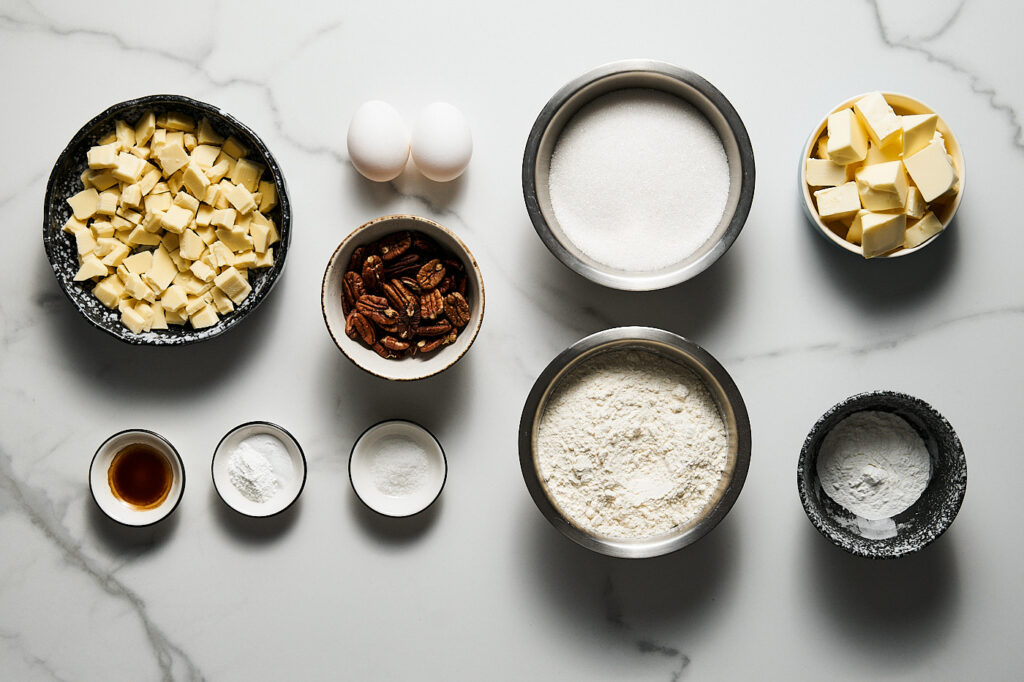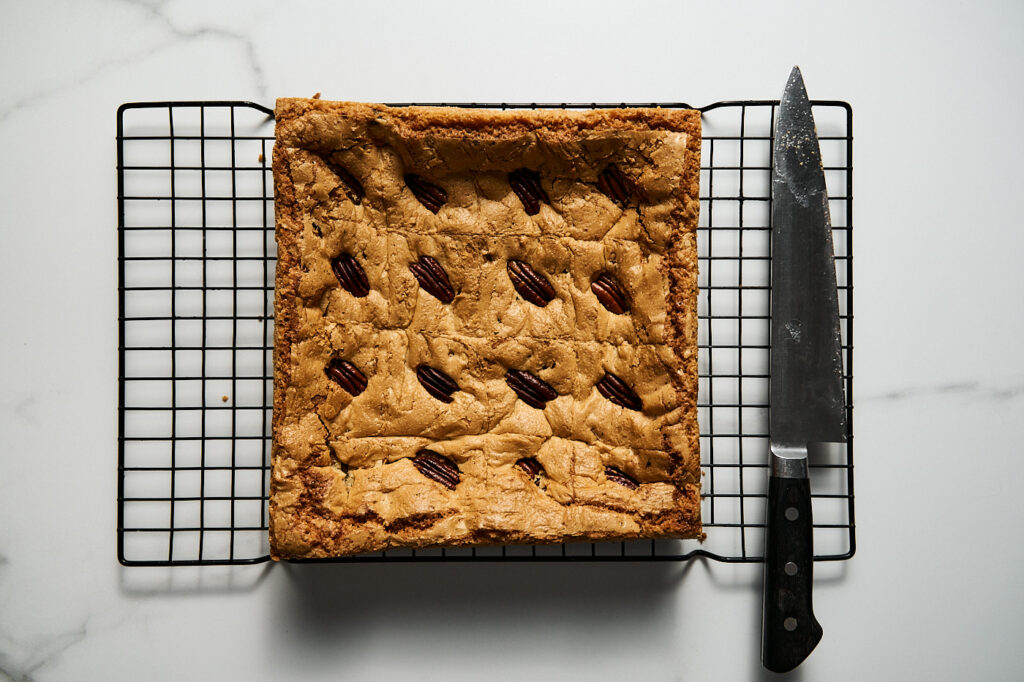Blondies are a popular dessert that resembles a beige-colored cake or pie. In simple terms, blondies are brownies made from white chocolate. Some even call them “white brownies,” but in reality, they are separate desserts with their own unique texture and taste.
The history of blondies dates back to 20th-century America. They are believed to have emerged as an alternative to traditional chocolate brownies, initially created for those who prefer more delicate and lighter desserts.
A distinctive feature of this recipe version is the addition of cornstarch to the batter. It gives the batter a more uniform and “chewy” texture.
The taste of these blondies is sweet and delicate, filled with the aroma of vanilla, with a crispy crust on the outside and a soft, slightly moist texture inside.
Pecan nuts add a crunchy texture and a slightly salty aftertaste, making the blondies even more interesting.

Contents:
⏱ Cooking time — 1 hour and 50 minutes overall. Includes 30 minutes of preparation and cooking + 1 hour and 20 minutes unattended.
🥣 Ingredients
🍽 For 9 or 16 squares:
- 220 g (7,8 oz) unsalted butter, plus extra for greasing the pan
- 240 g (8,5 oz) white chocolate
- 320 g (11,3 oz) granulated sugar
- 1 tsp. vanilla extract
- 2 eggs, lightly beaten with a whisk
- 250 g (8,8 oz) all-purpose flour
- 30 g (1,1 oz) cornstarch
- ½ tsp baking soda
- 1 tsp. baking powder
- pinch of salt

🔪 Directions
Preheat the oven to 180°C (360°F).
Melt the butter (5 minutes)
Transfer 220 g of unsalted butter to a saucepan and melt it over low heat.
Prepare the sugar-egg mixture (10 minutes)
In the meantime, measure 320 g of white sugar into a large bowl, break 2 eggs into a separate bowl and beat them with a fork.
Set the beaten eggs aside.
Pour the melted butter into the sugar, vigorously whisking the mixture. Beat the eggs again slightly with a fork and add to the sugar mixture. Whisk until homogeneous.
Add 1 tsp. of vanilla essence and set the bowl aside.
Prepare the dough (10 minutes)
Sift 250 g of all-purpose wheat flour into another large bowl. Also sift 30 g of cornstarch, 1 tsp. of baking powder, and ½ tsp. of soda into the same bowl.
Add a pinch of salt. Pour the egg-sugar mixture in three to four parts, vigorously whisking the contents of the bowl each time.
Mix the dough with a whisk as much as possible, then switch to a silicone spatula.
Adding nuts and chocolate (5 minutes)
Set aside 16 pecan nuts for garnishing the top of the blondies, and chop the rest.
Add the chopped nuts to the dough. Also add 240 g of white chocolate. Stir until uniform.
Preparation of the form and baking (40 minutes)
Line the bottom of a baking form with parchment paper and grease it and the sides of the form with butter. Place the dough in the form and level it out.
Visually or using a ruler, divide the dough into 9 (3×3) or 16 (4×4) squares and make notches with a knife. Place one nut in the center of each square.
Bake in the oven at 180 °C (360 °F) for 35-40 minutes.
Cooling and cutting the blondies (40 minutes)
The outside of the blondies will have a crispy crust, while the inside will remain soft and moist.
Move the blondie form onto a cooling rack. Once it has cooled down a bit, remove the blondies from the form and let them cool completely on the rack. After that, transfer them to a board and cut them into squares.

🌶Variations
- Brown Sugar. Replace half of the white sugar with brown sugar to give the blondie a caramel flavor and slightly chewier texture. Replace half of the white sugar with brown sugar to give the blondie a caramel flavor and slightly chewier texture.
- Spices. Add a pinch of cinnamon or nutmeg to the dry ingredients to impart a warm, spicy flavor that complements the sweetness of the blondie.
- Nuts. Experiment with different nuts, such as walnuts, almonds, or hazelnuts instead of pecans. Each type of nut will give the blondie a unique flavor and texture.
- Dried Fruits. Add some dried cranberries, raisins, or chopped dried apricots to the batter to make the flavor more diverse.
- Citrus Zest. Add the grated zest of one lemon or orange to the batter for a fresh, bright aroma.
- Toppings. Drizzle cooled blondies with melted chocolate or caramel sauce. You can also sprinkle sea salt on top of the blondies before baking to create a contrast of sweet and salty.

🥡How to Store
Cooling
Before storing, allow the blondies to completely cool on a wire rack at room temperature. This will prevent them from getting soggy due to trapped moisture.
In the Refrigerator
Transfer the cooled blondies to an airtight container and store in the refrigerator for up to one week. Refrigerating will help maintain their freshness and texture.
Freezing
To store the blondies for a longer period, wrap individual pieces in plastic wrap or aluminum foil and place them in an airtight container or a freezer-safe zip-top bag. Label and date the container and freeze for up to 3 months.
Defrosting and Reheating
To enjoy the blondies at their best, defrost them in the refrigerator overnight if frozen, then reheat in a preheated oven at 150°C (300°F) for 5-10 minutes or until fully warmed. Alternatively, you can use the microwave at medium power for 20-30 seconds. This will restore the soft and moist texture of the blondies.

The Origin of the Blondie Dessert
The Blondie dessert, often described as a brownie without chocolate, has a history shrouded in sweetness and mystery. Its story begins in the United States, although its exact origin point is difficult to pinpoint.
One tale suggests that the Blondie dessert was born out of economic necessity during the Great Depression. At that time, in the early 20th century, financial hardships meant that common kitchen ingredients like chocolate were viewed as a luxury many couldn’t afford. Resourceful homemakers wanting to make a sweet treat without breaking the bank started experimenting with available ingredients.
They substituted the cocoa powder or chocolate normally found in brownies with brown sugar, giving birth to a bar cookie that was lighter in color but no less delightful in taste. This “blonde” version of the traditional brownie was aptly named a “Blondie”.
The brown sugar created a rich, sweet, and often gooey interior, reminiscent of caramel, earning the Blondie dessert its other popular name, the “blonde brownie” or “butterscotch brownie”.
Despite the necessity-driven origin story, Blondies quickly became a beloved dessert across America. Over the years, different variations have emerged, with bakers adding in nuts, chocolate chips, and even swirls of cream cheese to the basic mix.
One of the earliest published recipes for Blondies can be found in a regional cookbook from the Midwest, dating back to the 1940s, further cementing this dessert’s place in American culinary history.
Today, the Blondie dessert is appreciated worldwide for its simple, comforting sweetness and soft, chewy texture. It stands as a testament to the creativity and resilience of those early bakers who, faced with limitations, still managed to create a dessert that continues to delight the sweet-toothed to this day.
The Texture of a Blondie Dessert
One of the defining features of a Blondie dessert is its distinct and delightful texture. This dessert bar is cherished for its dense, moist, and chewy interior, a result of the brown sugar caramelizing during baking.
At first glance, a Blondie may appear to be a simple dessert, but the texture reveals a complexity that is both satisfying and indulgent. When you take your first bite, the exterior has a subtle crispness, almost like a crust, giving way to a soft and chewy center. The inside texture is quite similar to a traditional brownie, although it’s lighter in color.
This dessert strikes a delicate balance between the consistency of a moist cake and the denseness of a cookie. The result is a satisfyingly chewy treat that feels substantial without being overly heavy.
Many variations of the Blondie incorporate mix-ins such as chocolate chips, nuts, or dried fruit, adding an extra layer of texture. The crunch of chopped nuts or the burst of sweetness from dried fruits or chocolate chips can complement and elevate the Blondie’s naturally soft, chewy texture.
Overall, the texture of the Blondie dessert is a significant part of its appeal. It’s this perfect blend of chewiness and softness that has made it a favorite among dessert lovers worldwide. Whether eaten warm from the oven or cooled and cut into squares, the comforting, chewy texture of a Blondie is an experience in itself.

Blondie with Pecan Nuts

Ingredients
- 220 g unsalted butter plus extra for greasing the pan
- 240 g white chocolate
- 320 g granulated sugar
- 1 tsp. vanilla extract
- 2 eggs lightly beaten with a whisk
- 250 g all-purpose flour
- 30 g cornstarch
- ½ tsp. baking soda
- 1 tsp. baking powder
- 1 pinch salt
Instructions
- Preheat the oven to 180 °C (360 °F). Melt the butter over low heat in a saucepan.
- Measure the sugar, beat the eggs separately, then mix the melted butter with the sugar. Add the beaten eggs and vanilla essence.
- In a separate bowl, sift the flour, cornstarch, baking powder, and baking soda, add the salt. Pour in the egg-sugar mixture, vigorously beating. Knead the dough with a whisk, then with a spatula.
- Set aside 16 pecans, chop the rest. Add the nuts and white chocolate to the dough, mix.
- Line the mold with parchment, grease with butter. Put the dough, level it, divide it into squares, make notches, put a nut on each square. Bake at 180°C for 35-40 minutes.
- Cool the blondie on a wire rack, remove it from the mold, let it cool completely, cut into squares.
